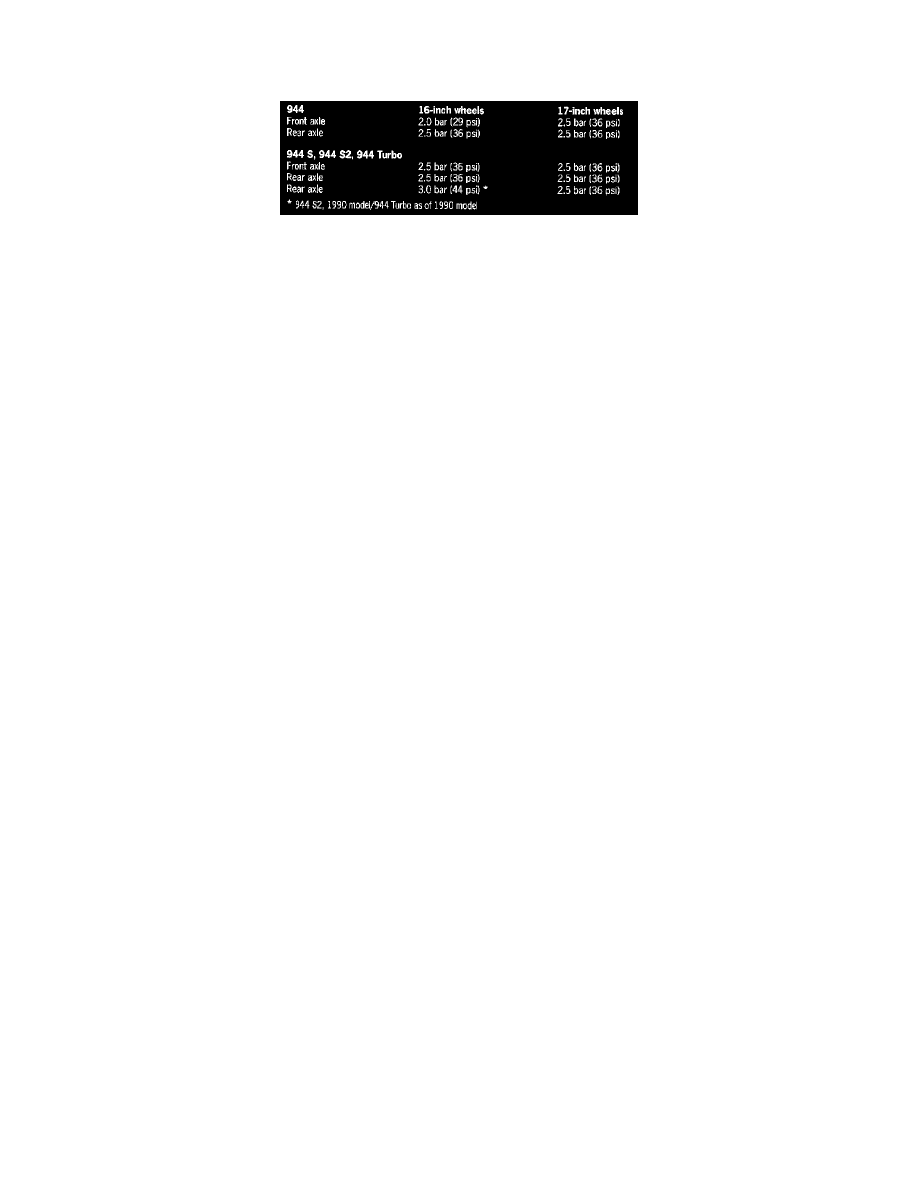944 S L4-2479cc 2.5L DOHC (1987)

and Inside/Outside marking
= directional mounting on specified side only
If there are no mounting instructions on the tire sidewall, the tire must be mounted so that the DOT code is visible from the outside.
Tire Pressure:
This tires pressure applies only to the tire makes and types approved by Porsche, and is specified for cold tires (approx. 20 degrees C/68 degrees F).
The tire pressures must never be lower than the specified values.
General Info:
Always use new valves when changing tires:
Always observe any possible instructions concerning the rolling direction and/or specifying which side the tires must be mounted on. Refer to notes (if
applicable).
Coat the tire beads and humps with mounting lubricant before mounting the tire. This ensures that the tire beads will slide over the humps easily. In order
to prevent the tire from turning on the wheel, avoid extreme driving maneuvers (acceleration and braking) during the first (100 to 200 miles) with new or
recently mounted tires.
In order to optimize smoothness of rolling, it is appropriate - and necessary in individual cases - to mount the tire in a certain (favorable) position with
respect to the wheel (matching). Matching (uncontrolled and controlled) is explained below:
Uncontrolled matching: Turning the tire on the wheel by 90 degrees or 120 degrees if necessary in order to achieve an acceptable value with regard to
rolling smoothness (true running, imbalance and weight distribution of balance weights).
Controlled matching: With a balancing machine with matching program. In most cases, this produces an even better result with regard to the rolling
smoothness (true running, imbalance and weight distribution of the balance weights) than can be achieved with uncontrolled matching. Maximum
permissible radial runout and lateral runout of the wheels < 0.7 mm. Maximum permissible radial runout and lateral runout of the wheels with tires <
1.25 mm. Values < 1.50 mm - ideally approx. 0.5 mm - are desirable.
The mounting pressure (seating pressure) of 58 psi/4.0 bar overpressure must not be exceeded before both tire beads are evenly seated on the rim flange.
If new tires are to be mounted or the tires of one axle are to be replaced, tires of the same make, the same type and with the same specification code must
always be used on each of the two axles. If tires are replaced on one axle only, the different tread depth from that on the other axle can cause a noticeable
change in the familiar handling. This is especially the case if new tires are mounted on the rear axle. This effect decreases with increasing tire mileage.
When replacing a tire on an axle, make sure that the tread depth of the new tire does not differ from that of the other tire by more than 30%.
If a tire is damaged and it cannot be determined with absolute certainty that there is no ply damage - with all of its consequences - or if the tire was
thermally or mechanically overloaded due to a loss of pressure or other prior damage, we recommend replacement of the tire in question for safety
reasons.
Repairs on "V", "W", "Y" and "ZR" tires are not allowed, as is the use of inner tubes in tubeless tires. Tires age due to chemical and physical processes,
which can impair their function. Tires that are stored unused for an extended period harden and become brittle faster than tires that are in continual use.
Hairline aging cracks can occur on older tires. On tires in continual use, the kneading action activates the plasticizer in the rubber and thereby prevents
hardening and cracking.
Therefore, attention should be paid not only to the tread depth but also to the age of the tire. tires should not be older than 6 years. The age of the tire can
be determined via the DOT code on the sidewall, which indicates the production date of the tire: e.g. DOT 2201 = 22nd week of 2001.
Tires/complete wheels must be stored in a cool, dry and dark room with adequate ventilation. They must never come into contact with fuel, oil, grease or
chemicals.
Complete wheels can be stacked for storage; it is advisable to increase the tire pressure by 6 psi (0.4 bar). Optimum conditions for proper storage of the
complete wheels are provided by the Original Porsche storage stand (trolley), Part Number 000 044 000 38.
If the tires are not mount on wheels, it is best to store them in vertical position. Tires stored in vertical position should be turned every two weeks in
